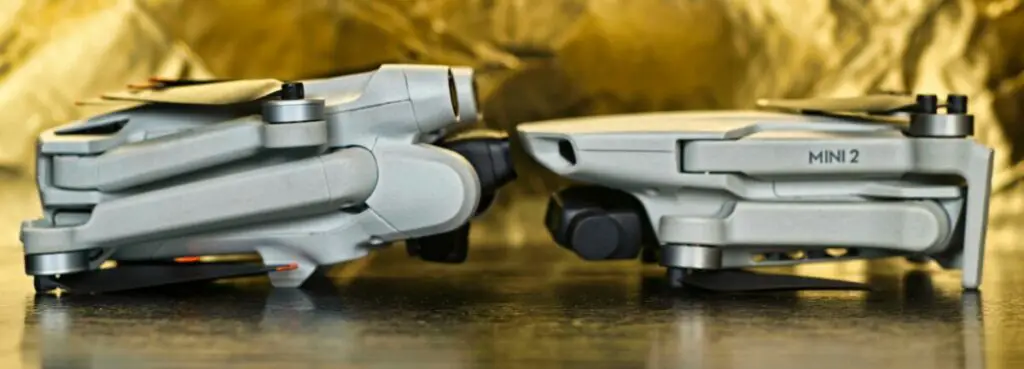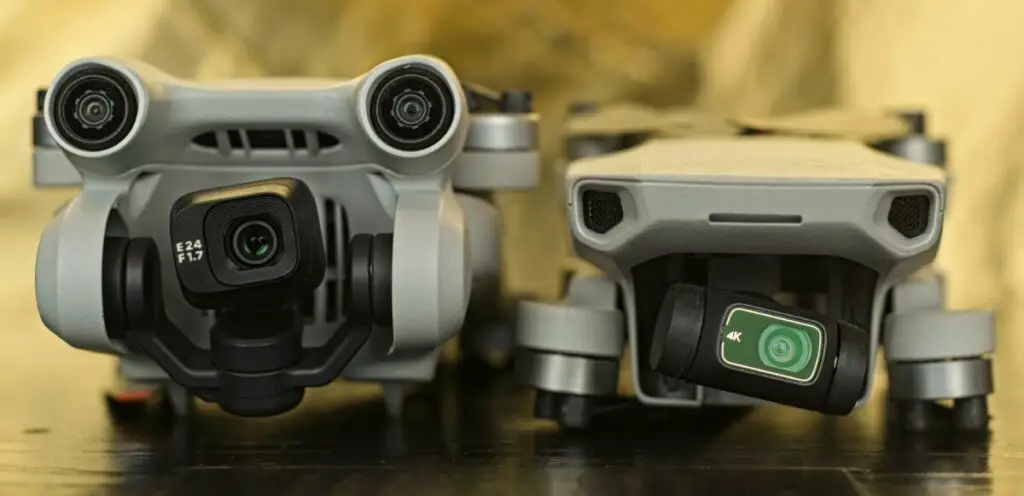The Mini 3 Pro has an array of useful functionalities for video and surprisingly good footage quality, especially in low light. It was released one and a half years later than the Mini 2 and the advance in technology is evident. The Mini 2 is suggested only to users on a budget starting with drones
Other related articles:
- Mini 3 Pro vs Mini 2 overall comparison
- Mini 3 Pro vs Mini 2 Photo quality comparison
- Mini 3 and 3 Pro video quality
- Mini 3 vs 3 Pro, which lightweight drone to buy?
If you prefer to watch this as a video, you will find my YouTube version at the end of this article
Video Specs and Features
| Mini 3 Pro | Mini 2 | |
| Weight | 249 grams | 249 grams |
| Sensor size | 1/1.3″ | 1/2.3″ |
| Aperture | f 1.7 | f 2.8 |
| Field of view | 82.1° (24 mm) | 83° (24mm) |
| Video resolution | 4k at 60 fps | 4k at 30 fps |
| Video bitrate | 150 Mbps | 100 Mbps |
| Color profiles | Normal, D Cinelike | Normal |
| Sensing system | Tridirectional | None |
| Max flight time | 34 minutes (47 with Plus battery) | 31 minutes |

Mini 2
The Mini 2 was released in November 2020
The sensor is way too small for today’s standards and this is not a good omen for dynamic range and low-light footage
It was a considerable effort at the time to squeeze a drone below 250 grams, thus this model has limited functionalities: it only offers Quick Shots and a basic Panorama mode
It also lacks obstacle sensors and tracking capabilities
There is only one color mode, the 8-bits Normal
Being the cheapest model of the line offering 4k video, it is often considered the drone for beginners, although the lack of obstacle avoidance requires a lot of care by inexperienced users

Mini 3 Pro
The Mini 3 Pro is a powerhouse with practically the same features as the excellent Air 2S, plus vertical video and photo mode, a big selling point for users who are active on social media platforms
It offers tridirectional obstacle sensors at the front, back, and bottom with tracking capabilities and useful intelligent features like:
It is considerably more expensive, but it is in a different league in terms of video functionalities
The Mini 3 Pro has a much bigger sensor, a very wide fixed aperture of f1.7, and a video resolution of 4k with a frequency of up to 60 fps, which is useful for slow-motion
Besides Normal, there is also a flat 10-bit color profile, D Cinelike, suitable for serious post-processing
Footage Quality
Top-down
Let’s start with some shots with the camera tilted down. The sky is not on the frame, therefore the dynamic range is low and we can concentrate on detail and color rendition
In this first scene of a garden, both clips have good detail and pleasant colors.
I can spot a touch of extra detail in the vegetation with the Mini 3 Pro
In the architectural features, the Mini 3 Pro has more detail, especially in the darker areas
I also prefer the color rendition of the Mini 3 Pro
Normal Mode
Let’s start with some images containing the sky
The light is far from ideal, we are in summer, there is plenty of dampness in the air and it is hard to tell the difference between the sea and the sky
But this is good for comparison because in a bad light is easier to spot the difference in quality between two models
The Mini 2 performs decently in easy light. The technology has moved very fast in drone footage, but it can still be considered acceptable
The Mini 3 Pro is in a different dimension. After some post-processing and shadow lifting, the detail is excellent and the colors very rich, an astonishing performance
All clips have been taken one right after the other, at about 3 minutes of difference. Exposure and white balance are manual. The value for White Balance is 5500 Kelvins for both models
I have also compared the Mini 3 Pro vs the Mini 2 for photography in this specific article
DJI Mini 3 Pro in D Cinelike Mode
The Mini 3 has a second profile, the flatter D Cinelike
It performs better in high dynamic situations and can stand heavier post-processing
It is especially useful to adapt footage to the color scheme and the mood of a specific project
After several updates, D Cinelike is now a respectable 10-bit mode
Low Light
Low-light footage is a strong point of the Mini 3 Pro
Due to the larger sensor and the very wide aperture of the lens, it can gather plenty of light even at low ISO values and maintain plenty of detail in the shadows without any noise
The Mini 2 with its small sensor and older technology cannot compete under the same conditions
Even in the darkest scenes, the level of noise of the Mini 3 Pro is acceptable and can be perfectly managed using Neat Video, the excellent denoiser that I use constantly, more details about Neat Video in my specific article
